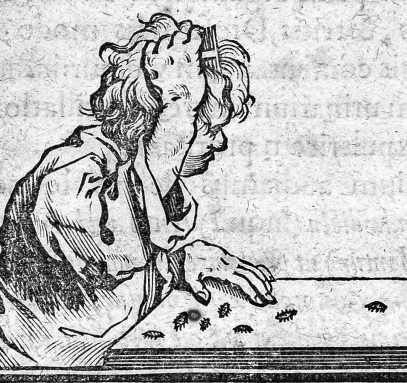
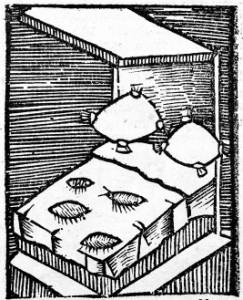
Credit: Wellcome Library, London
Many people, myself included, have an aversion to the sensation of things crawling over our skin, whether it be insects, arachnids, or other creepy crawlies. In the early modern period it would seem that people were much more accustomed to having their bodies invaded by visitors, but, like us, found these unwanted guests most disturbing. This aversion to creepy crawlies was brought vividly to my imagination earlier this year at a talk Sasha Handley (@sashahandley) gave about sleeping in early modern England, which she concluded with a wonderful illustration of gigantic bed bugs!
So what creepy crawlies threatened the early modern body? Well in the Secret Miracles of Nature Levinus Lemnius described that worms were a particular problem for men’s bodies. These did not necessarily crawl over the skin but could be most unpleasant:
It hath been seen sometimes miraculously, that long and round Worms especially, have crambled upwards, and crept forth at the mouth and the nostrils: and they do this by an imbred natural motion, if a man be long fasting. For then they bite the stomach, and seek for meet, and when they find none to satisfie them and preserve their lives, they creep upwards, and hunt for meat as far as the very throat. For they by their natural instinct perceive, that the food comes in that way, and the nostrils being open to the very throat almost, they creep thither, and tickle the part, or else they are cast forth by sneesing, or are pulled forth with ones forefingers.1
Worms not only came out of the throat and nose but according to some texts were voided in the urin: ‘I saw a Man who had the Colick (of whom I spake in the Colick) that made Urin with infinite small worms like mites in cheese, swimming alive therein; which dying, sanke down in a great lump to the bottom. And I saw the same after in others’.2 Hannah Newton has also noted that worms were particularly thought to affect the bodies of infants and children.3
Worms weren’t the only problem. Samuel Pepys recorded in his diary that his maid removed lice from his body as part of his hygiene regime.
So to my wife’s chamber, and there supped and got her cut my hair and look my shirt, for I have itched mightily these six or seven days; and when all came to all, she finds that I am louzy, having found in my head and body above 20 lice, little and great; which I wonder at, being more than I have had I believe almost these 20 years.4
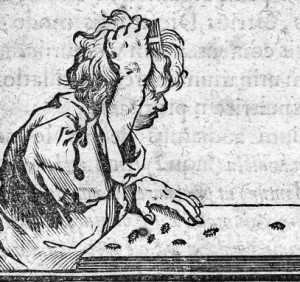
Credit: Wellcome Library, London.
Samuel Hartlib also recorded in his Ephemerides for 1643 that perfuming the body with the smoke of quicksilver killed lice. He noted that this remedy was ‘Probatum’ (proven) suggesting that he, or someone he knew, had put this to good use in removing lice from the body. In 1656 he likewise recorded that oil of turpentine drove away all fleas, lice and other vermin, and that it could be rubbed on a child’s stomach to force worms out of their bodies by vomiting or by stool.5
Pepys noted, in addition to lice, that fleas affected his quality of sleep. On Saturday 3 September 1664 he noted that ‘I have had a bad night’s rest to-night, not sleeping well, as my wife observed, and once or twice she did wake me, and I thought myself to be mightily bit with fleas, and in the morning she chid her mayds for not looking the fleas a-days.’6
Fleas didn’t confine themselves to the hair. The 1664 edition of Platerus golden practice of physick illustrated, for its readers, the possibility that fleas would find their way into the ears: ‘The things that get into the Ears, and out again, are chiefly water, when they swim; also Fleas, and Lice, Chinches, Ear-wiggs, and other creeping things, as worms, the earwig is most feared.’7
Unwelcome guests falling or crawling into the ears appears to have been a particular concern. Salvator Winter’s New Dispensatory for example suggested ‘For an Earwig in the Ear. THe Juice of Wormwood, Rew, and Southernwood, of each a like quantity, put it into the Ear, and lay some of the beaten Herbs unto it, and that will kill it in one night’.8 The recipe collection attributed to Anne Brumwich similarly recorded ‘A Medicine to kill any quick thinge as flye or flear that is crept into [th]e eare’.9
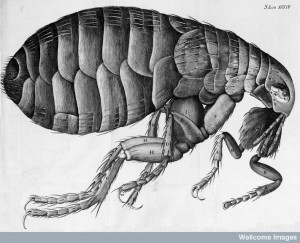
Credit: Wellcome Library, London.
Knowledge about these unwanted visitors was improved during this era as well, as the invention of the microscope allowed them to be viewed and visualised with much greater detail. Robert Hooke’s publication Micrographia became famous for its detailed drawings of microscope observations and in particular this delightful image of a flea. I wonder if reading about such things in medical books and recipe collections or seeing others scratching at their bodies left people itching, the way writing this blog post has left me feeling decidedly itchy and vulnerable?
________________________________
1. Levinus Lemnius, The Secret Miracles of Nature (London, 1658), pp. 83-4.
2. Felix Platter, Platerus Golden Practice of Physick (London, 1664), p.677.
3. Hannah Newton, The Sick Child in early modern England (Oxford, 2012), pp.45-6.
4. The Diary of Samuel Pepys, Entry for 23 January 1669, Vol 9, p.424.
5.Greengrass, M., Leslie, M. and Hannon, M. (2013) The Harlib Papers. Published by HRI Online Publications, Sheffield [ available at:http://www.hrionline.ac.uk/hartlib ]. [30/4/89B] and [29/5/86A]
6. The Diary of Samuel Pepys online http://www.pepysdiary.com/diary/1664/09/03/
7. Felix Platter, Platerus Golden Practice of Physick (London, 1664), p. 686.
8. Salvator Winter, A new dispensatory of fourty physicall receipts (London, 1649), p. 13.
9. Wellcome Library, MS. 160, p.53.
© Copyright Jennifer Evans all rights reserved.
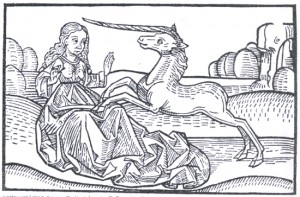


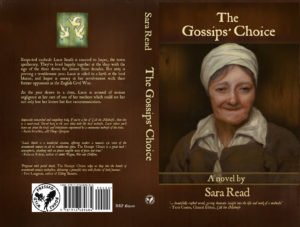
3 thoughts on “Feeling ‘Louzy’”
Comments are closed.